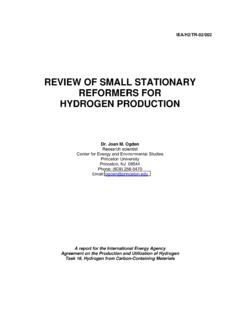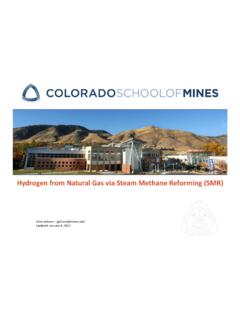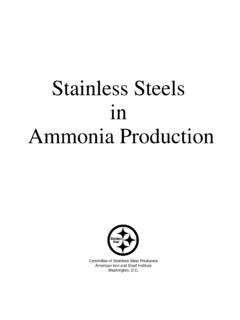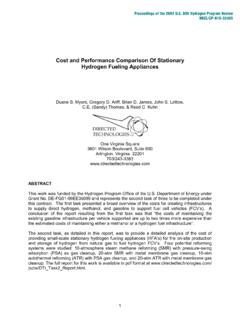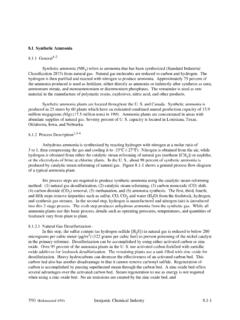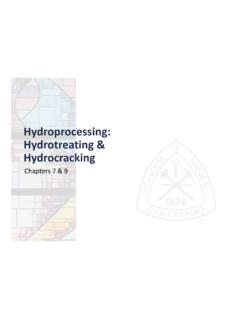Transcription of Hydrogen Production via Steam Reforming with CO2 …
1 Hydrogen Production via Steam Reforming with CO2 Capture Guido Collodi Foster Wheeler Via Caboto 1, 20094 Corsico Milan - Italy Hydrogen demand in refineries is increasing vigorously due to the stringent transportation fuel specifications, furthermore the interest in the so-called Hydrogen economy developed in the recent years put the Hydrogen as energy carrier in the centre of a growing interest. More than 95% of the Hydrogen for refinery use is nowadays produced via hydrocarbon Steam Reforming , where Foster Wheeler plays an active role both as a technology and Steam Reforming furnace (the Terrace Wall ) supplier.
2 Depending on the quality of the feedstock (natural gas, rich gases, naphtha, etc.), one ton of Hydrogen produced will also produce 9 to 12 tons of CO2. As a consequence, from carbon emissions point of view, besides the optimisation of the Hydrogen balance (Stockle and Bullen, 2008) and the improvements in Production technologies, CO2 capture is also an option to be considered. The paper will examine the possibilities of CO2 capture in a Steam Reforming based plant, and its impact on the economics of Hydrogen Production . 1. The Steam Reforming Hydrogen Plant For many years, Steam methane Reforming (SMR) has been the leading technology for generation of Hydrogen in refining and petrochemical complexes.
3 The Steam Reforming plant consists of four basic sections (Bressan et al., 2009): The first is feedstock treatment where sulphur and other contaminants are removed. The second is the Steam methane reformer, which converts feedstock and Steam to syngas (mainly Hydrogen and carbon monoxide) at high temperature and moderate pressure. In case of multiple or heavy feeds and/or for large capacities, an adiabatic, catalytic pre- Reforming step is foreseen upstream the SMR. The third section is the syngas heat recovery and incorporates CO shift reactor/s to increase the Hydrogen yield. The final section is the raw Hydrogen purification, in which modern plants employ a pressure swing adsorption (PSA) unit to achieve the final product purity.
4 In addition to the core process sections, compression is often needed to raise the feedstock and product Hydrogen pressures. The Reforming reaction between Steam and hydrocarbons is highly endothermic and is carried out using specially formulated nickel catalyst contained in vertical tubes situated in the radiant section of the reformer. The simplified chemical reactions are: CnH2n+2 + nH2O = nCO + (2n+1)H2 (for saturated hydrocarbons) CH4 + H2O = CO + 3H2 delta H = + 206 kJ/mol (for methane) In the adiabatic CO shift reactor vessel, the moderately exothermic water gas shift reaction converts carbon monoxide and Steam to carbon dioxide and Hydrogen : CO + H2O = CO2 + H2 delta H = - 41 kJ/mol The PSA purification unit removes from the Hydrogen , by adsorption, CO, CO2 and CH4 gases.
5 SMR is a mature technology and is now less likely to yield any large step changes in economic benefit from technological developments. Marginal economic improvements are the order of the day. 2. The CO2 Balance in the Hydrogen Plant In a modern Steam Reforming Hydrogen plant fed by natural gas, up to approx. 60% of the total CO2 produced is contained in the shifted gas (and then in the PSA tail gas), while the remaining 40% is the product of the combustion of the additional fuel gas required by the Steam reformer. At last, all the CO2 ends up in the flue gas of the SR heater. (See Figure 1 below) Figure 1 Simplified H2 block flow diagram Steam reform Shift PSA H2 Fuel gas Tail gasFeed Flue gas.
6 Typical CO2 flow rates and partial pressures for a 100,000 Nm3/h ( MMSCFD) Hydrogen plant are reported in the following Table 1. Table 1 Typical H2 plant CO2 balance Stream CO2 concentration (% mol) CO2 flow rate (kmol/h) CO2 partial pressure (bara) Raw H2 (PSA inlet) 1,000 PSA tail gas 1,000 SR flue gas 1,850 It is clear from this example that one ton of Hydrogen produced will also produce about 9 tons of carbon dioxide. The CO2 could be captured from any of these three streams (see Figure 2), with removal efficiency of about 90% (from PSA tails gas and from SR flue gas) and up to more than 99% (from raw H2 at higher pressure).
7 Figure 2 CO2 removal locations The total CO2 potentially removed ( CO2) from the three locations, calculated with the formula CO2 (%) = 100 x (1 CO2 in flue gas after in flue gas without CO2 rem.) is reported in Table 2. Table 2 Achievable CO2 removal CO2 removed from: CO2 removed from each stream (%) Overall CO2 (%) H2 (PSA inlet) 100 60 tail gas 90 55 flue gas 90 90 It is also possible, in principle, to combine CO2 removal 1 or 2, with 3 (from flue gas), and obtain an overall CO2 of about 96 and 94% respectively. Steam reform Shift PSA H2 Fuel gas Tail gas Feed Flue gas CO2rem. 1 CO2rem. 2 CO2 rem. 3 . 3. CO2 removal technologies There are several and different available technologies for CO2 removal, at different stage of development and commercialisation.
8 The next paragraphs will quickly review such technologies and their application. For sake of simplicity, the review is here limited to the CO2 removal cases 1 and 3, yet recognising the potential carbon capture also from PSA tail gas. CO2 removal from syngas (raw H2) The CO2 removal from syngas is performed at relatively high total pressure (25-30 barg) and CO2 partial pressure (3-4 bara). There are several technologies available, most of them being used in ammonia plants CO2 removal section, or in the old fashion Hydrogen plant, before the introduction in the market of the PSA technology for Hydrogen purification. Main technologies include: Amines (MEA, MDEA, aMDEA); Hot potassium carbonate; Physical solvents (PEGE, Methanol); Membranes.
9 The first three categories use liquid solvents in an absorption/regeneration sequence. The chemical solvents in this application are generally less expensive than the physical ones and allow an almost complete removal of the CO2; depending on plant layout, the CO2 stream is made available at high purity (say > vol) and at a pressure of barg. Membranes performances in terms of removal efficiency and purity are expected to be lower. When a traditional plant is retrofitted with the addition of such removal unit, the Steam reformer burners have to be checked for the new tail gas composition which, being poorer in CO2, has a higher tendency to NOx formation, with the consequence that low-NOx burners and/or space for a future installation of a de-NOx catalytic system in the convection section of the heater, could be considered at the design stage.
10 As a consequence of the retrofit the PSA will have some capacity margin due to the reduced inlet flow rate after CO2 removal. Licensors active in these technologies include: BASF, Giammarco-Vetrocoke, Linde, Lurgi, UOP, etc. CO2 removal from flue gas As indicated in Table 1, the CO2 present in the Steam reformer flue gas has a very low partial pressure (about bara) and the flue gas actual volumetric flow is 20 times or more the raw syngas volumetric flow (m3/h). These two factors and the presence in the flue gas of components like oxygen, sulphur, NOx, dust, makes the CO2 removal from this stream generally more complicated and expensive.










